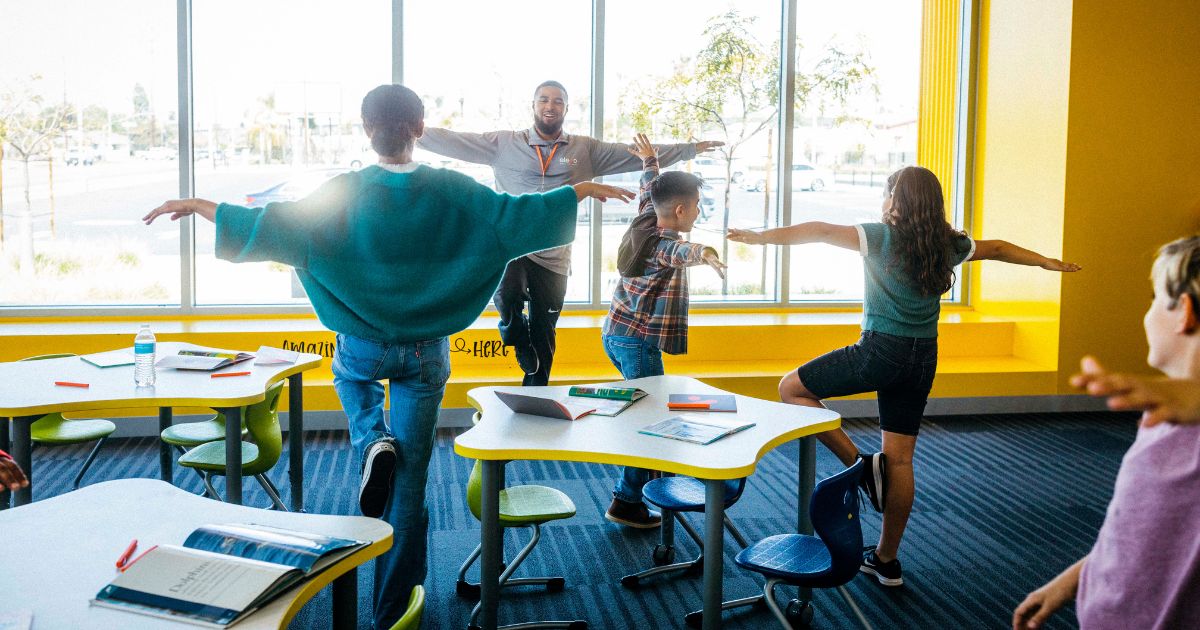
Para español desplácese hacia abajo.
At Elevo, everything we do is built around our Five Core Practices. From a Warm Welcome to an Optimistic Closure, Elevo coaches are trained in these practices, which support the development of the whole child and create safe and supportive learning environments. Our approach focuses on strengthening students’ physical, mental, and academic well-being. We’re proud to foster a positive environment that allows students to find meaning in their experiences and build essential skills.
Today, we’ll be exploring what it means to utilize Supported Transitions to give students predictable routines throughout their time with us. Here’s how we support their healing and growth through our structured approach.
What are Supported Transitions?
Supported Transitions are designed to create predictability and routine during an otherwise unstructured and potentially chaotic time. Some of the students we serve have faced hardship in all its forms, so our goal is to acknowledge their challenges during transitions.
What others may be quick to deem as bad behavior may be a complex trauma response. By establishing structure during these times, we can help reduce all students’ anxiety, fear, and maladaptive behaviors.
What Do Supported Transitions Look Like?
Step 1: Our coaches first prime our students for the change in activity by giving them a heads-up that it’s coming. This gives them the opportunity to prepare for the new direction that the session is moving in.
Step 2: Coaches then get their students’ attention, so all eyes are on them and all students are silent. Many of our coaches find attention getters to be successful for this. When their students are already paying attention, coaches will not need to raise their voices or otherwise trigger sensitive students.
Final Thoughts
For both students who have faced immense challenges and those who have not, Supported Transitions can help them move seamlessly from activity to activity. When our coaches are able to create structured routines for them, our students will continue to thrive in the classroom and beyond.
Círculos Comunitarios de Elevo: Fomentar Conversaciones Intencionales
En Elevo, toda nuestra programación es desarrollada con el tema de nuestras Cinco Prácticas Centrales. De las Bienvenidas Cálidas a los Cierres Optimistas, los maestros de Elevo reciben entrenamiento en estas prácticas que apoyan el desarrollo holístico del niño, y crean un ambiente de aprendizaje seguro y apoyador. Nuestro método se enfoca en fortalecer el bienestar físico, mental, y académico de los estudiantes. Estamos orgullosos de fomentar un ambiente positivo que permite que los estudiantes tengan experiencias significativas y desarrollen habilidades esenciales.
Hoy, exploraremos lo que significa utilizar las Transiciones con Apoyo para darle rutinas predecibles a los estudiantes durante su tiempo con nosotros. Así es como apoyamos su sanación y crecimiento con nuestro método estructurado.
¿Qué son las Transiciones con Apoyo?
Las Transiciones con Apoyo están diseñadas para crear previsibilidad y rutina durante un tiempo que es potencialmente caótico y con falta de estructura. Algunos de los estudiantes que apoyamos se han enfrentado a la adversidad en todas sus formas, entonces nuestra meta es reconocer sus desafíos durante las transiciones.
Es posible que lo que otros llaman el mal comportamiento realmente sea una reacción compleja al trauma. Al establecer una estructura durante estos tiempos, podemos ayudar a reducir la ansiedad, el miedo, y los comportamientos maladaptativos en los estudiantes.
¿Cómo se aplican las Transiciones con Apoyo?
Paso 1: Nuestros maestros comienzan a preparar a los estudiantes para un cambio de actividad, dándoles un aviso de que un cambio viene en seguida. Esto les da la oportunidad de prepararse para la nueva dirección de la sesión.
Paso 2: Luego, los maestros obtienen la atención de sus estudiantes, de modo que cada estudiante esté mirando al maestro, y que estén guardando silencio. Muchos de nuestros maestros han observado que los captadores de atención son útiles para este paso. Cuando sus estudiantes están poniendo atención, los maestros no necesitan alzar la voz, previniendo el desencadenamiento de los estudiantes sensibles.
Esta rutina ayuda tanto al maestro como a los estudiantes conforme progresa la sesión. Durante este proceso, los maestros se aseguran de utilizar un tono firme, lenguaje corporal seguro, y contacto visual consistente.
Pensamientos Concluyentes
Tanto para los estudiantes que han enfrentado desafíos inmensos como aquellos que no, las Transiciones con Apoyo puede ayudar a que ambos cambien de una actividad a otra con facilidad. Cuando nuestros maestros crean rutinas estructuradas para ellos, los estudiantes continuarán prosperando en el salón y más allá.




